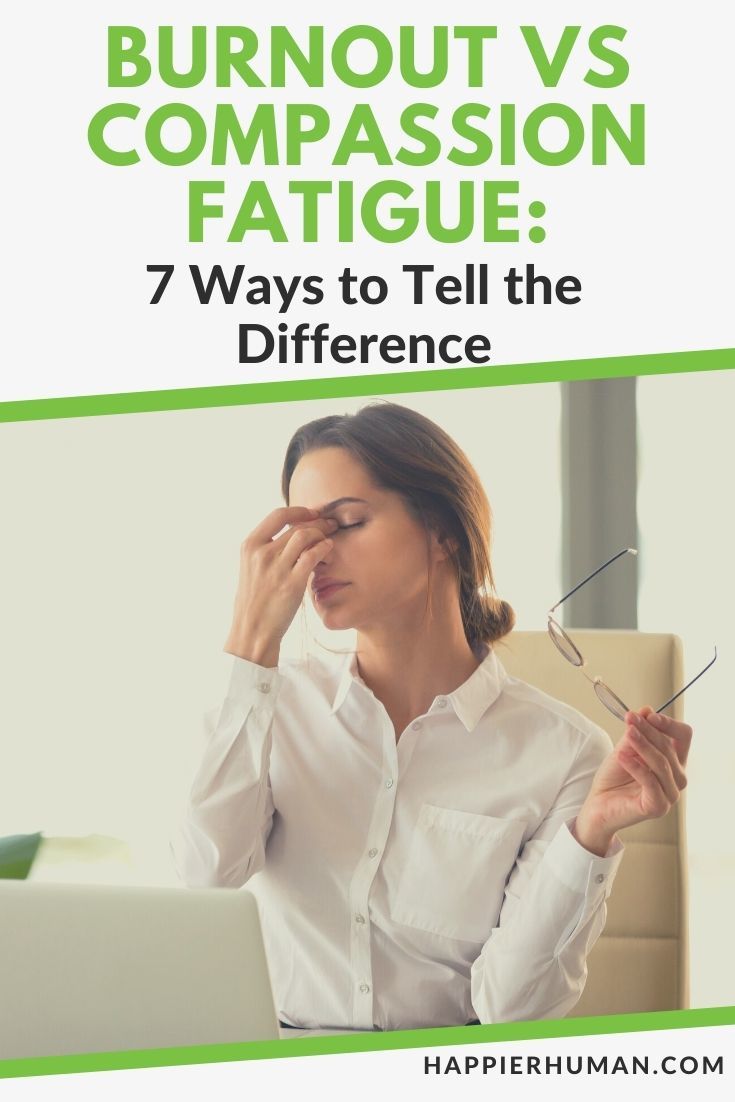When I first heard of compassion fatigue, I thought it was just another pretentious term for people who mismanage their emotional investments.
I couldn’t have been more wrong.
After some revealing discussions with a couple of friends who were all working in the medical field, my perspective changed significantly.
But it wasn’t until I started working as a therapist that I truly felt the burden of compassion fatigue.
Long story short, I came to realize that people CAN reach physical and emotional exhaustion when their job involves caring for others, regardless of how emotionally resilient they may be.
And since you can’t stop being compassionate just like that – especially when it’s part of your job – it’s vital to cultivate healthy practices that restore your physical and emotional balance.
Is There Such Thing As ‘Compassion Fatigue’?
In essence, compassion fatigue describes a state of exhaustion that you experience after spending considerable time with people who are dealing with emotional or physical suffering.
I don’t see compassion fatigue as an ‘illness’ or problem, but merely the cost of caring.
Whether you’re looking after a sick family member or working as a nurse, as long as you’re in a position where you need to provide compassion and care, you will eventually reach emotional exhaustion.
Sometimes, compassion fatigue can be the result of a tragedy that impacts a specific group. One example is the COVID-19 pandemic, which, according to a recent study, has led to an increase in burnout and compassion fatigue among healthcare professionals.
Interestingly, the social recognition that healthcare professionals have received over the last year has acted (to some extent) as a buffer, diminishing the negative impact of emotional exhaustion.
The real problem occurs when you ignore the symptoms and lose sight of your needs. That’s when burnout and depression begin to take a toll on your health and well-being.
There’s no treatment or cure for compassion fatigue. But there’s plenty you can do about it.
Most mental health professionals will recommend roughly the same strategies as they would for stress and burnout.
More specifically, it’s all about prevention, good emotional management, and solid self-care routines.
Who Is at Higher Risk?
Based on current scientific evidence, it seems healthcare professionals are at the highest risk of developing compassion fatigue.
From nurses, doctors, and emergency care workers to grief counselors and social workers, any professional whose job is to look after people in critical condition are at risk.
I would also add police officers, firefighters, and volunteers working with vulnerable groups to the list.
What’s interesting is that most of the studies I found focused on nurses. In a way, we could speculate that they spend more time interacting with patients than doctors and other healthcare professionals.

In short, perhaps nurses are at the highest risk of developing compassion fatigue.
But since it’s not a competition, you need to remember that whenever you find yourself surrounded by others’ pain and suffering, it’s vital to remain connected to your needs; to show compassion towards yourself from time to time.
Compassion Fatigue vs. Burnout: What’s the Difference?
Given the similarities between these two conditions, people often mistake burnout for compassion fatigue and vice versa.
Although I wouldn’t say this confusion is a tragedy, knowing precisely what you’re dealing with gives you a better sense of control over your mental and emotional well-being.
The more you understand the difference between burnout and compassion fatigue, the better you can adjust your coping strategies.
Burnout develops over time; compassion fatigue strikes suddenly.
In general, burnout results from prolonged exposure to stressful environments where job demands exceed your emotional and mental resources.
In other words, you could reach burnout after several months (or years) of constant stress, depending on your resilience and emotional maturity.
As for compassion fatigue, there are times when even one day in the presence of someone who’s hurting is enough to leave you emotionally drained.
Compassion fatigue can be a precursor of burnout.
As I said earlier, burnout occurs when you’re dealing with constant and excessive demands that outweigh your emotional resources.
But “demands” can mean anything from job-related tasks and school projects to being emotionally available for someone who’s going through a rough patch.
As a caregiver, if you neglect your emotional well-being long enough, you will eventually burn out.
It’s easier to recover from compassion fatigue than from burnout.
On a brighter note, compassion fatigue is relatively easier to manage than burnout.
Sometimes, 30 minutes exclusively for yourself can be enough to restore your emotional balance.
Given that burnout syndrome is a severe condition, it will take more than just 30 minutes of self-care to overcome it.
But just because compassion fatigue a relatively ‘lighter’ condition, don’t fool yourself into thinking you can ignore it.
7 Warning Signs of Compassion Fatigue
Depending on your personality, family history, and other factors that have contributed to your psycho-emotional development, you might be inclined to think that YOU MUST care.
Or that it’s selfish to put your needs above others.
And that’s when shame gives rise to denial, one of the most common signs of compassion fatigue and also the reason why people dealing with this condition tend to misjudge their emotional state.
1. Irritability
When you’re running low on emotional resources, even small inconveniences like the bus arriving late or the dirty dishes your spouse left in the kitchen sink tend to drive you crazy.
You always feel on edge, and you throw snappy remarks at anyone who dares to disturb you.
2. Emotional and physical exhaustion
Although it’s specific to a wide range of conditions, physical and emotional exhaustion is probably the most obvious sign of compassion fatigue.
You feel drained and lifeless, like a walking corpse, and all you want to do is shut down.

Some might even say that the level of exhaustion you experience after caring (emotionally) for someone who’s in a lot of pain is comparable to a day of hard physical labor.
3. Depersonalization
Depersonalization is a feeling of alienation from oneself and one’s body. It’s like seeing yourself from the outside.
Even though you’re fully aware that this sensation is merely an impression that doesn’t reflect reality, it could still cause frustration and stress.
In a way, this symptom is a coping mechanism that your mind uses to disconnect from all the pain and secondary trauma that you’ve witnessed for an extensive period.
4. Self-blame
When they reach exhaustion, people dealing with compassion fatigue tend to blame themselves for wanting to take a break.
In other words, you feel ashamed for not being 100% dedicated to alleviating the physical or emotional pain of someone who’s under your care.
The worst part is that self-blame can make you disregard your mind’s desperate cry for a moment of calm and recharge.
5. Ruminating thoughts about the suffering of others
When you’re always around people dealing with trauma or illness, their stories and sufferings tend to ‘stick’ to you at some point.
Even when you’re home, you occasionally find yourself ruminating on their struggles, thinking of ways to alleviate their pain and restore their happiness.
By doing so, you rob yourself of any opportunity to recharge and reconnect with yourself.
6. Self-medication and substance abuse
Substance abuse and self-medication are relatively common among those who struggle with compassion fatigue.
It’s easier to numb that unpleasant feeling of emotional exhaustion than to invest in healthy coping strategies that could restore your sense of balance and happiness.
7. Relationship issues
As in the case of any other condition that affects your emotional well-being, compassion fatigue can have a profoundly negative impact on your relationships.
When you pour all your energy into caring for others, there’s not enough ‘you’ left for those who love and could support you.
Here’s How You Can Regain Balance
The reason why I’ve mentioned self-care repeatedly throughout this article is that I want you to understand how important it is to care for yourself before caring for others.
Whether you’re working in a field where illness and suffering are part of the job or taking care of someone close who’s going through a rough patch, don’t lose yourself in their struggles.
It’s Ok to Take a Break!
As a caregiver, your job is to provide compassion and support. The people you care for rely on you for physical, medical, or emotional assistance.
In such circumstances, it’s easy to take on full responsibility for other people’s well-being and lose sight of your needs.
And even if you feel emotionally drained, there’s something that’s keeping you from prioritizing yourself.
Maybe you feel like there’s no energy left to care for yourself, or perhaps you feel like you don’t deserve it simply because the other person has it worse than you.
In my experience, guilt is often the reason why caregivers refuse to distance themselves (for a moment) from all the illness and suffering they witness day in, day out.
Whenever you’re exhausted but feel too guilty to take a break, ask yourself this: How will I be able to help the person I care about if I don’t give myself time to recharge?
Taking some time for yourself doesn’t make you a selfish person; it just makes you human.
Set Boundaries
The first thing you should do to prevent compassion fatigue is to set clear boundaries.
One recent paper revealed that, along with self-care and self-awareness, professional boundaries are a ‘must’ for healthcare workers who are at risk of developing compassion fatigue.
But once again, guilt can trick you into taking on more responsibilities than you can handle or replying to texts outside working hours.
Here’s how you can set healthy professional boundaries:
If you’re providing care for a sick family member or maybe a friend who’s been through a traumatic event, there’s a good chance you might feel less comfortable setting boundaries.
But just because you have an emotional connection with the person receiving care doesn’t mean your well-being shouldn’t be a priority.
There’s no easy way to set boundaries, but we do it because it’s healthy, and it keeps us strong enough to be there for someone, day in, day out.
Practice Mindfulness
When it comes to stress, burnout, and compassion fatigue, mindfulness meditation is undoubtedly the best practice you can include in your daily routine.
For social workers and professionals who encounter trauma and emotional stress, mindfulness can increase compassion satisfaction and decrease compassion fatigue.

Mindfulness creates space for a different perspective, one in which you don’t need to identify with your emotions. Whether you feel grateful, exhausted, helpless, or confused, you know that every emotion is a temporary experience.
And it’s this perspective that gives you the chance to simply pause, observe, and refresh without getting caught up in all the pain and suffering that you witness.
Plus, it’s easy to practice and doesn’t take up much of your time.
For example, I like to use the Headspace app because it’s user friendly and only takes 10 minutes of my time.
You will be surprised how much calm you can gain from 10 mindful minutes.
Invest in Self-Care Routines
Mindfulness is just one of the many self-care practices that can help you prevent compassion fatigue.
But just because mindfulness meditation is presented as a beneficial practice doesn’t mean it works for everyone. After all, we’re different people with different needs and thinking styles.
If you’ve tried mindfulness (for at least several weeks) but didn’t felt any improvement, here’s a list of self-care practices that can help you recharge and recalibrate:
Remember, there are no universal solutions for compassion fatigue or any other emotional difficulty you may be struggling with.
You just need to find what works best for you.
Seek Professional Help
Just because compassion fatigue isn’t a form of emotional illness per se doesn’t mean it can’t cause complications.
When it goes unnoticed and unmanaged (or managed poorly), this condition could lead to severe emotional problems like burnout syndrome or depression.
If, for some reason, you feel like all the strategies mentioned above haven’t paid off and you’re still living in survival mode, perhaps it’s time to consult a professional.
Paradoxically, healthcare workers are often reluctant to seeking counseling or therapy services. Since they already have the “recipe,” some believe they should overcome emotional difficulties on their own.
But if reality proves that you can’t do it alone, maybe you should stop seeing yourself strictly as a professional and start treating yourself as a human being, a person who will always have vulnerabilities despite his/her training and expertise.
Final Thoughts on Compassion Fatigue VS Burnout
Compassion fatigue (or secondary trauma) is a burden for anyone who cares and shows compassion towards those dealing with illness, suffering, or trauma.
But you don’t have to carry this burden 24/7.
As long as you,
… you will be able to prevent emotional exhaustion and enjoy life, despite the pain and suffering that you witness every day at work.
Don’t let compassion fatigue rob you of your personal life.
If you wish to keep on helping others, prioritize your happiness and well-being.
And if you're looking for more resources on overcoming any overwhelm, check out these blog posts:
- 25 Simple Living Tips to Experience Less Stress
- How to Deal with Feeling Overwhelmed with Life: 7 Steps
- 7 Warning Signs That You Need a Mental Health Break

Alexander Draghici is a licensed Clinical Psychologist, CBT practitioner, and content writer for various mental health websites. His work focuses mainly on strategies designed to help people manage and prevent two of the most common emotional problems – anxiety and depression.


